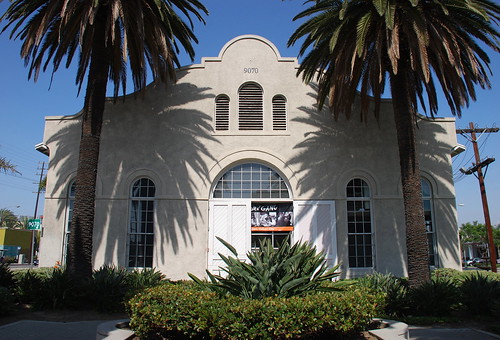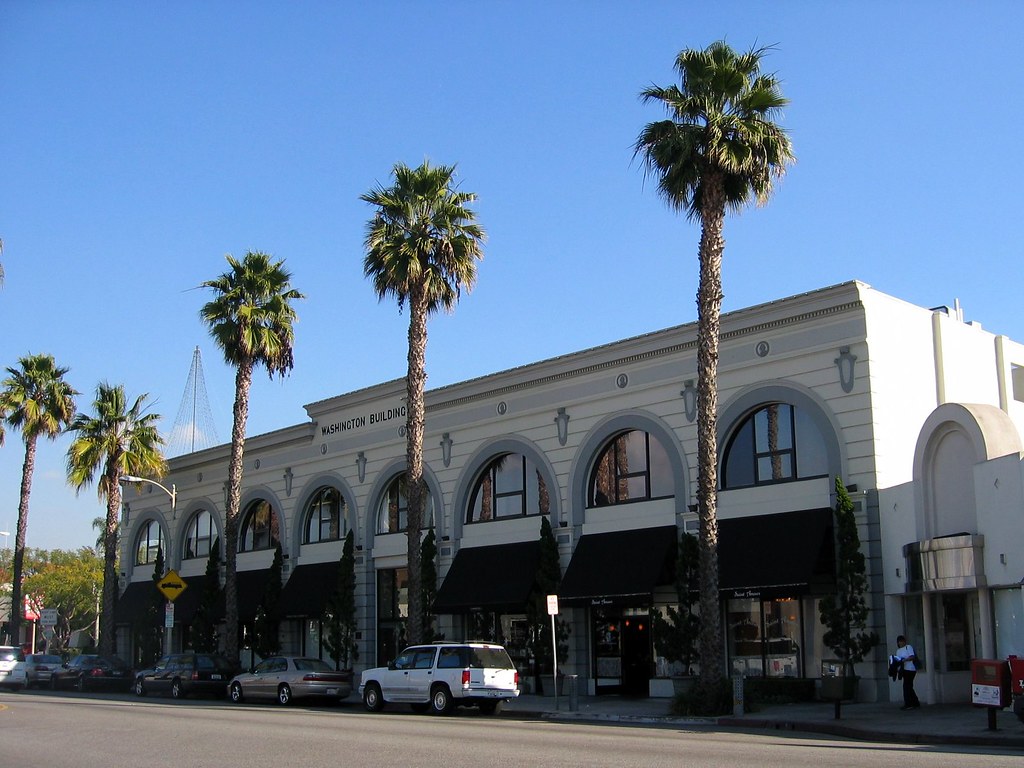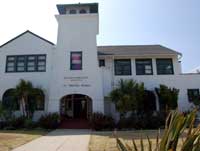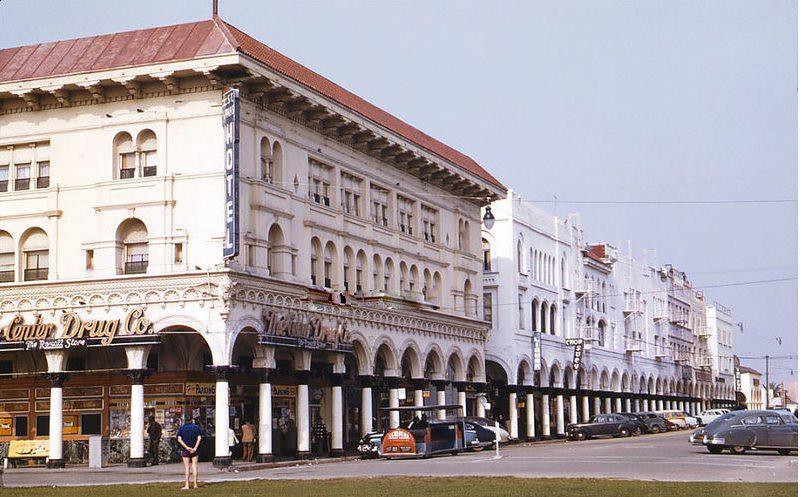Interactive map - click and zoom! Click here to view the map separately!
Ahhh, Spring is finally in the air. A time for more daylight, colorful native floral blooms, Dodgers baseball and...CicLAvia! The first Cicla of 2017 brings us back to a virtual re-run of the August 2015 "Culver City Meets Venice" route from The Heart of Screenland (which will be celebrating its 100th birthday this September) to Abbot Kinney's canal city via Mar Vista - although there's a minor modification - the addition of two streets and an alleyway forming a pedestrian zone in Mar Vista between Centinela and Grand View avenues.
This is the 20th iteration of CicLAvia, and The Militant still has yet to miss a single one. So for those of you 20-timers who will be on the streets this Sunday, The Militant will celebrate by pouring a Dos Equis at an unspecified bar or restaurant along the route. If you happen to spot him (not very likely, but who knows?) Then drinks are on The Militant!
You should know the drill by now, Share this link on your Facebooks and Twitters, visit the sights yourselves -- and if you do, Tweet with the hashtag, #EpicCicLAviaTour to stroke The Militant's ego and make him feel like his several days of staying up late at night to research and write all this was worth his while. And most of all, Stay Militant and Enjoy CicLAvia this Sunday! See you or not see you on the streets!
2012
Venice and National boulevards, Culver City
You may or may not have arrived at CicLAvia via the Metro Expo Line, which is the modern reincarnation of the Pacific Electric Santa Monica Air Line. Not only can you experience Los Angeles' transportation present, but you're also in the clear presence of its past -- this area was also the site of Culver Junction, where not one, not two, but three Pacific Electric Red Car lines converged, going to Santa Monica, Venice and Redondo Beach. TIP: Make sure you buy a Day Pass or that your TAP card is well-loaded before CicLAvia, so you don't have to queue at the ticket machines! The Militant says "You're Welcome."
1918
Ince Blvd & Washington Ave, Culver City
As you make your first turn going westbound on the CicLAvia route, take note of the street name: Ince.
If you know your Culver City history, the town was a planned community built by landowner Harry H. Culver, a Spanish-American war veteran who worked for SFV pioneer Isaac N. Van Nuys and purchased a large section of the old Rancho La Ballona. In 1913 he established the town and filmmaker Thomas Ince moved his operation here from Pacific Palisades (via his Triangle Studios down the street -- more on this later...) and bought this section of land from Culver himself to establish the Ince Studio, which featured a large mansion fashioned after George Washington's Mt. Vernon residence, that remains in full view today. Ince's studio was sold to Cecil B. DeMille after his mysterious death and had changed hands and names over the years, finally adopting its current name of The Culver Studios in 1970. Legendary Hollywood films were shot this studio, including Gone With The Wind, King Kong, E.T. and The Matrix.
 3. Pacific Electric Ivy Substation
3. Pacific Electric Ivy Substation1907
Venice and Culver boulevards, Palms
Downtown Culver City is already rich in retail and artistic activity, and has a bevy of well-known eateries, like the popular Father's Office. The Militant can cover that in its own post (and kinda already did before). But welcoming people to Downtown Culver City along Venice Blvd (though technically located in the Los Angeles neighborhood of Palms), a block from the Culver City station is an appropriate link to the past - the Ivy Substation. The single-story Mission Revival-style structure served as a powerhouse for the Pacific Electric Railway from 1907 to 1953, when the Expo Line's predecessor, the Santa Monica Air Line, ceased operation. Today, it's a 99-seat venue for The Actor's Gang theatre company, renovated in the early 1990s. How interesting that a building originally built for transportation infrastructure was repurposed into a building for the arts, which in turn attract people using the new transportation infrastructure.
1924
9400 Culver Blvd, Culver City
5. The Washington Building
1927
9718 W. Washington Blvd, Culver City
Culver City's other 1920s-era triangular building is just down the street from The Culver Hotel. Built by Charles E. Lindblade, a business associate of Harry Culver who also bears a city street name of his own, this Beaux Arts-style building was designed by Arthur D. Scholz and Orville L. Clark. As it is today, the building housed numerous retail and office businesses over the years, including the Culver City post office, the MGM Studios Fan Club and Lindblade's real estate company.
1946
9820 W Washington Blvd, Culver City
Built in 1946 as The Culver Theatre, a 1,100-seat Streamline Moderne cinema designed by Karl G. Moeller that screened 20th Century Fox films as part of the Fox West Coast Theatres chain.
It was later operated by the National General and Mann Pictures chains, and finally as an independent theatre. It was split into three screens circa 1970s, and closed in 1989. In 1994, it suffered damage from the 1994 Northridge Earthquake and underwent a major $8 million renovation later in the '90s, re-opening in 2004 as The Kirk Douglas Theatre (with Spartacus himself as a the major contributor in the renovation), operated by Center Theatre Group. It currently features two stages, one seating about 300 and a smaller stage seating around 100.
1915
10202 West Washington Boulevard, Culver City
One can't mention Culver City without mentioning its massive movie lot, originally Thomas Ince's (remember him?) Triangle Studios operation until he moved to the Culver Studios property and sold this site to D.W. Griffith and Mack Sennett. In 1918, the studio was sold to Samuel Goldwyn, which became Metro Goldwyn Mayer in 1924 (following the merger of Metro Pictures, Goldwyn Studios and Louis B. Mayer Productions). It became the Columbia Pictures studios in 1989 and Sony Pictures Studios from 1992 to the present.
On this lot was filmed a countless list of Hollywood productions, most notably The Wizard of Oz in 1939 (you will be riding next to the actual Land of Oz, think about that...), and currently, TV shows like Jeopardy! and Wheel Of Fortune.
1865
10915 W Washington Blvd, Culver City
This local school is literally some old school Culver City right heah! Established in 1865, it's one of the oldest schools in Los Angeles County still in operation. Back in the day, it had an enrollment of 158 pupils between the ages of 5-15, being taught by one teacher, a Miss Craft who made $50 a month, and the school year lasted seven months, since it revolved around the agricultural calendar of the surrounding area.
When it was established, it was in an unincorporated area that eventually became Palms, which was annexed to the City of Los Angeles in 1914. When Culver City was founded the year before, it had no schools within its boundaries, so another school was built in the area in 1916. Eventually La Ballona was annexed into Culver City in 1920.
1995
10980 Washington Boulevard, Culver City
This Islamic house of worship was built in 1995 as a gift from Saudi Prince Abdulaziz bin Fahad to serve the growing community of Muslims in the Westside, named after the king of Saudi Arabia at the time. Its facade features hand made marble tiles from Turkey, and a 72 foot-high minaret topped with a gold leaf crescent.
10. Tellefson Park/Rollerdrome Site
1976/1928
1105 W. Washington Pl, Culver City
There's a designated activity hub here at this 1.5-acre Culver City park, which was dedicated in 1976 as part of the U.S. Bicentennial celebrations. It was named after former Culver City councilman and city attorney Mike Tellefson, who served the city for 31 years. In 2013, the body of a suicide victim was discovered in the park.
But longtime Culver Citizens remember this site as a legendary roller skating rink called The Rollerdrome, a wooden structure which opened in 1928 and had a characteristic rounded roof. Roller skating events were centered around the rink's organ, which was played by a live organist, and provided memorable evenings for local families and youths. It was torn down in 1970, which was a shame, since roller skating enjoyed a renaissance of sorts in the '70s.
1959
11222 Washington Pl, Culver City
Many Angelenos already know of this longtime Westside (American) taco joint known as Tito's Tacos, which as we all know, was founded in 1959 by a businessman who may or may not be an actual Mexican guy named Tito. Everyone has their opinion on Tito's, but three things are indisputable truths: 1) It's a Culver City Institution; 2) It's not authentic Mexican food and 3) People come here for the nostalgia anyway.
During the last "Culver City Meets Venice" CicLAvia in August 2015, a minor controversy erupted when the restaurant's owner threatened to sue Culver City government for potential lost revenue due to the CicLAvia route, and everyone, including The Militant got all in on that, but ultimately, cooler heads prevailed, and after an intervention by the CicLAvia organization, Tito's Tacos warmed up to the route, and likely did a 180 once crowds queued up along their sidewalk service windows. Titogate 2015 was now history. The moral of the story? Never fear CicLAvia, and a little communication and understanding goes a long way.
12. The Oval District/Palm Place
1912
Area within Washington Place, McLaughlin Ave, Venice Blvd & Inglewood Blvd, Mar Vista
You might not see much from the street level, but this neighborhood just north of the CicLAvia route, a Historic Preservation Overlay Zone known as "The Oval District" is one of the first automobile-oriented property tract developments in Southern California.
When seen from a map or an aerial view. the streets of this 200-unit housing development of predominantly 1- and 2-story homes resembles an hourglass shape with an oval road in the center (which caught The Militant's eye and caused him to investigate the history of the place).
The 137-acre neighborhood was developed in 1912 by a Lillian Charnock Price (there is a "Charnock Road" two blocks north of Venice, BTW) who hired renowned landscape architect and urban planner Wilber David Cook, Jr. (who worked for legendary late 19th/early20th-century landscape architect Frederick Law Olmsted to design an "Aristocratic Suburb" marketed as “Palm Place."
The large-sized lots were unique, and park-like in their large setback from the street and the palm tree-lined parkways, but only a small number of homes were built. Price sold the development to Robert Sheman, who was the stepson of Moses Sherman, the developer of the Los Angeles and Pacific Railway, which built the original rail line on nearby Venice Boulevard. What was originally intended to be the first car-oriented development was going to be a transit-oriented development!
But those didn't sell either. The lots were still too large and pricey. So Sherman sold it to a financier group that marketed it as "Marshall Manor" in 1920 and interest began to pick up. But it wasn't until after World War II, when suburbanization was in vogue and Los Angeles' Westside development boom commenced, that the rest of the lots got built.
13. The Mar Vista Pedestrian "Canals"
2017
CicLAvia route between Centinela and Grand View avenues
The end of the CicLAvia route might be more associated with canals, but this newly-added section of the course features a pedestrian-friendly (a.k.a. Dismount City, folks!) zone of activities in the Mar Vista area. The zone includes the Mar Vista Farmers' Market, a couple cafes, a yoga studio and a pet store that features a pet adoption event (on National Puppy Day Weekend, no less).
14. Mar Vista Hill (a.k.a. The 'Mar Vista' in Mar Vista)
1924
Centinela Ave & Rose Ave, Mar Vista
Everyone know that "Mar Vista" is Español for "sea view." But riding along Centinela or Venice during CicLAvia, you can't even see the sea. Where is it?
Well, The Militant will tell you where to see the "Mar Vista" in Mar Vista. He implores you to take a short detour from the CicLAvia route and continue north along Centinela Avenue, switch your gears (or pedal harder, you fixie heads), and go up the hill (Mar Vista Hill) until you reach Rose Avenue. Then turn right and go up the hill to the open space that contains the baseball field and community garden. Look to the west, stand on top of the telephone poles laying on the ground in front of the small parking lot, and you can have a semi-unobstructed (damn you, DWP power lines!) view of Santa Monica Bay from the Palos Verdes peninsula to the Santa Monica Mountains.
Mar Vista Hill is a 203-foot-above-sea-level promontory that was once a garbage dump, and was later the site of the Venice Reservoir in 1940 (smart, huh). The reservoir was decommissioned in the 1960s and replaced with the baseball fields you see today.
So come on up to Mar Vista Hill, where you can see the sea, to see all that you can see!
Go visit Mar Vista Hill and tweet a pic of the ocean with the hashtag #EpicCicLAviaTour!
1964
Venice Boulevard between Lincoln Blvd and the 10 Freeway
You may or may not know that Venice Boulevard, in addition to being a two-time CicLAvia route, was also a Pacific Electric Red Car line, but did you know it's also a designated California State Highway?
In 1964, CalTrans designated State Route 187 starting at the Pacific Ocean. In 1994, it was shortened to the 5.4 miles from Lincoln Boulevard to the 10 Freeway.
The number "187" also happens to be a reference to the California Penal Code designation for murder, which is most likely why a young, '90s-era, pre-commercialized Snoop Dogg is standing by the sign in this photo.
16. Mario's Brothers Market
12904 Venice Blvd, Mar Vista
No deep history behind this neighborhood Mexican corner market on Venice and Beethoven, but the name caught The Militant's eye. He's seen some of you CicLAvians ride in CicLAvia in Mario/Nintendo cosplay, so this would be a perfect photo/selfie opportunity.
While you're here, support the business and buy something inside. Maybe it really is owned by a Mario. Or a Luigi. Ask where The Princess is. If they're successful enough, they might move to a larger location and rename themselves "Super Mario's Brothers."
Tweet a pic of yourself (or your group) in front of Mario's Brothers with the hashtag "#EpicCicLAviaTour"!
1920
13000 Venice Blvd, Venice
Venice's namesake secondary school was one of three on-location sites for Rydell High in the 1978 motion picture Grease, and was the school scene in the Britney Spears video for her debut hit, "...Baby One More Time." The main Moderne-style school buildings, built in 1935-37 were designed by local architects John C. Austin and Frederick M. Ashley, who also designed the Griffith Observatory.
The campus is also famous for its statue of legendary Hollywood actress and famous alumna Myrna Loy at the front of the school. Other famous alumni include Beau Bridges, Crispin Glover, the late Ivory Queen of Soul, Teena Marie and In-N-Out Burger founder Harry Snyder. Go Gondoliers!
1911
681-685 Venice Blvd, Venice
Venice, originally founded as part of Santa Monica, seceded from that city in 1911 and for the next 15 years, functioned as an incorporated city. In 1926, due to political mismanagement and crumbling infrastructure, it was annexed into the City of Los Angeles. Its vestigial remnants of its civic government still remain, though. The old Venice City Hall still stands at 685 Venice Blvd (pictured), now the venue for Beyond Baroque Theatre. Next door on 681 Venice Blvd is the old Venice Police Station, now the home of the Social Public Arts Resource Center (SPARC), the community arts nonprofit that spearheaded the modern urban mural movement. It's interesting to note that both of these government buildings were adaptively re-used for arts purposes. The Militant is looking at the old LAPD Parker Center in DTLA and wonders if it could make some sort of badass performing arts venue...
 19. Electric Avenue
19. Electric Avenue1905
Electric Ave and Venice Blvd, Venice
No, '80s singer Eddy Grant didn't rock down to this street to take it higher (VROOOM!) But this street was so-named because it was one of the old Pacific Electric Red Car rights-of-way, which included Pacific Avenue (of course) and Venice Blvd. The railway, of course, was built to serve (and sell property in and around) Abbot Kinney's Venice of America development. Rock on to Electric Avenue towards Brooks Avenue and look to your left for actual remnants of Pacific Electric tracks at Millwood Avenue, Westminster Avenue and Broadway. If that kind of stuff excites you, be on the look out for The Militant's upcoming Pacific Electric Archaeology Map (view the preview edition map here, including Venice sites). And then we take it higher (Oh yeah)!
1992
Abbot Kinney Blvd between Washington Blvd and Main Street
New arrivals to Los Angeles are likely oblivious to the fact that Venice's upscale arts and boutique corridor is technically one of its newest streets. Until 1992, that stretch was confusingly known as West Washington Blvd, which, along with Washington Street and Washington Way, was a source of disorientation among motorists. A small group of business owners lobbied to re-name the stretch after the community's founder. Ignorance of local history was so bad back then, that then-City Councilman Zev Yaroslavsky, who grew up in the Westside, asked aloud at a Los Angeles City Council committee meeting, "Who is Abbot Kinney?" (Really, Zev?!?!) Thankfully, due to a street name change, and other things, we're a lot better at our Los Angeles history.
21. Venice Of America Centennial Park
2005
Venice & Abbot Kinney boulevards
This park, which neighbors the Venice-Abbot Kinney Memorial Branch Library and built for Venice's centennial year of 2005, was made on the very same median that carried the Pacific Electric Railway tracks, and in honor of that, the design on the park's paving resembles that of railroad tracks. The Militant went there in a famous bike ride to Venice Beach in 2008 and encountered a bunch of ducks walking in this park.
1929
Grand and Windward avenues, Venice
Traffic circles, or "roundabouts" as they're known in Britain, are not a common sight in the US, much less Los Angeles, though a dozen or so are known to exist here (more in a future post). So what up with this one? This part of Venice was part of Abbot Kinney's original "Venice of America," replete with its own canals. But unlike their Italian counterpart, these canals were not physically connected to the ocean, and the water had gone stagnant and kinda gross. By the 1920s, the Venice city infrastructure was falling apart (which meant little resources or political will to maintain the canals), and the automobile had started to conquer the streets of the Southland. So they were filled in circa 1929. The CicLAvia course on Grand Avenue was once the Grand Canal, and the traffic circle was formerly the location of a large saltwater swimming lagoon. The surviving canals, located south of Venice Blvd, were built by a different developer a couple years after Kinney's canals opened.
1905
Windward and Pacific avenues, Venice
The Windward Hotel, now a traveler's hostel, is not only the oldest hotel building in Venice, but its eastern ground floor entrance also functioned as Venice's Pacific Electric station. For the first half of the 20th Century, Venice was a popular western destination for the Red Cars, and the preferred way to go. North of Windward Way, there was no Pacific Avenue, but a dedicated "Trolleyway" for the Red Cars. When passengers disembarked at the Venice station before 1929, they were treated to an awe-inspiring view of the large lagoon (now the traffic circle) and canals just across the street, welcoming them to Venice of America. Now, for CicLAvia, when you arrive here, use your imagination and pretend to be transported back to a time when you didn't need cars to get around. On this day, it won't be that hard.
24. Pacific Electric Grand Canal Bridge
1905
Grand Canal at Venice Blvd, Venice
Ride just a few blocks down Pacific Avenue to Venice Boulevard to see Venice's characteristic namesake -- it's system of canals, built in 1905 by the aforementioned Mr. Kinney. The ornate concrete bridge spanning two side of the Los Angeles City parking lot near the Grand Canal is the original bridge that carried the Pacific Electric Venice Short Line tracks until 1950.





















